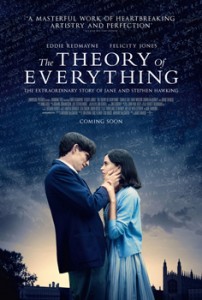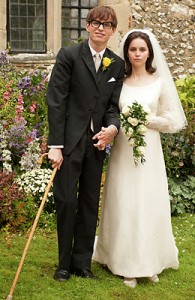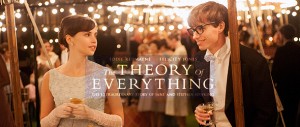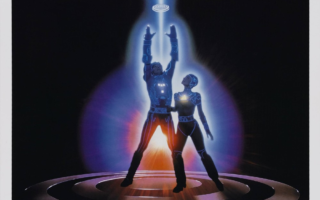 In The Theory of Everything, filmmakers were faced with the daunting task of bringing to the screen the true story of iconic astrophysicist Stephen Hawking. Rather than focusing upon his much documented scientific accomplishments however, James Marsh’s film took the unique route of delving into his personal story, specifically into the relationship with Hawking’s first wife, Jane. I was able to sit down with the people behind this touching film during a recent New York press day including actors Eddie Redmayne (who plays Hawking), Felicity Jones (Jane), director James Marsh and writer, Anthony McCarten.
In The Theory of Everything, filmmakers were faced with the daunting task of bringing to the screen the true story of iconic astrophysicist Stephen Hawking. Rather than focusing upon his much documented scientific accomplishments however, James Marsh’s film took the unique route of delving into his personal story, specifically into the relationship with Hawking’s first wife, Jane. I was able to sit down with the people behind this touching film during a recent New York press day including actors Eddie Redmayne (who plays Hawking), Felicity Jones (Jane), director James Marsh and writer, Anthony McCarten.
The first step in bringing The Hawking’s story to the screen was taken by writer Anthony McCarten, who like many people first encountered Stephen’s work in 1988 with his book, A Brief History of Time. “I think maybe ten million people bought the book and we all realized this was an extraordinary person” McCarten said, “Not only for the profundity of his ideas but just the nature of the man. This person with this compromised body, almost unable to use a single voluntary muscle. Able only to speak with a computer and yet telling us how the universe began, the nature of time itself…I thought somebody’s going to do an extraordinary movie about this guy at some point, never thinking I’d have any role in it.”
In 2004 however, McCarten came upon Jane Wilde Hawking’s autobiography, Traveling to Infinity—My Life with Stephen, and was inspired by a new perspective on Stephen Hawking’s life. “I don’t know what page it was I reached” he said of Jane’s work, “but it was something to do with the unorthodox love story that was unfolding in this book and I thought if you matched that to an already extraordinary story of Stephen, oh my god, you could do something quite unprecedented here.” McCarten took this inspiration all the way to Jane’s doorstep in Cambridge to offer his services in adapting her story to the screen. It began the years of work McCarten was to undertake on this screenplay. On working with Jane, McCarten added: “I will always be grateful for the fact that she didn’t turn this nutcase away and she let me come in, made a sandwich for me. We had a little glass of sherry and I presented this triple helix of a movie which is a love story but it’s also a horror story—of the physical decline of Stephen—and finally, it’s a story of physics. And she went as far as to say ‘look, I’ll let you write the script, but no promises’. And so I wrote the script and she liked it, she was reassured, she thought I might have the requisite sensitivity to deal with a delicate story like this. And so she let out a little bit more rope. Never giving me the option to her work, but ‘you can go a little further, let’s see what you do with the next step’. And that went on for eight years. Little more rope, going back to her. We became friends. Her book went out of print and I got it republished so I supported her too.”
Felicity Jones described her research into playing Jane as a “ a full frontal attack on understanding who this woman was” and also took the time to meet with her. “As soon as I met [Jane],” the actress said, “my job became so much easier. She is such an extraordinary woman. And there was something about her instantly that I loved, that she had this combination of something very ladylike—very sort of fifties ideal of what a woman is, she has this way of presenting herself that’s almost quite queenly. The way she moves, the voice she uses. So I worked with a dialect coach, a music and a movement coach to get the physical properties, so to speak, of who this woman was. But at the same time there’s a really core strength to her. There’s a formidable determination to her. And I loved this contrast between this very ladylike exterior but with this toughness underneath.”
Jane also helped Jones with very tangible research for her time with Stephen, Jones remembered “after talking with each other and she showed me photographs of her and Stephen when they first met, she really was very just open, and brought down clothes that she’d loved wearing when they were meeting. And I remember I’d been just talking to Jane for a few hours and  then Eddie [Redmayne] came around and I answered the door in Jane’s coat. Already there was an empathy between us. So I think what was important to Jane was to show the less glamorous sides of Stephen Hawking’s life. That their fame is one thing, but there was a whole support structure that was very intricate and complicated. And I was always just a champion of that story for her.”
then Eddie [Redmayne] came around and I answered the door in Jane’s coat. Already there was an empathy between us. So I think what was important to Jane was to show the less glamorous sides of Stephen Hawking’s life. That their fame is one thing, but there was a whole support structure that was very intricate and complicated. And I was always just a champion of that story for her.”
Beyond the emotional drama of the Hawking’s life, Eddie Redmayne was tasked with the difficult challenge of portraying Stephen’s physical decline after being diagnosed with motor-neuron disease at a very young age. On researching the role, Redmayne said “I went to an ALS clinic in London called The Queens Square Neurology Clinic for every week or two for four months. And with the specialists there… was introduced to people and families suffering from ALS and was invited to some of their homes. So trying to get a real sense of what the disease was but also the emotional ramifications of it on families. Also specifically taking photos of Stephen when he was younger. Because there’s no documentary material really before the eighties. It was trying to work what his specific physical decline had been. So by showing the specialist, she would see photos of…Stephen holding Jane’s hand and go ‘Ok, so by the way he’s holding the hand, you can see his hands have gone by this year…’ So then trying, then with the choreographer, trying to find a way of putting that into my body.”
I asked Eddie what specific changes he made in his performance of the young Hawking pre- and post-diagnosis. “What was interesting was where the disease starts,” Here, the actor got up to offer a physical demonstration, “Like the problem with ALS is often people are diagnosed because you fall. Like and because you’ve got foot drop which often is the first thing to go and your knee compensates by [Redmayne moves his knee forward without his foot landing] you don’t even realize your foot’s gone—so if your foot’s stopped working, your knee will just walk a bit higher and you won’t even realize your foot’s gone. And it’s only when you’re running one day that you’ll catch it and fall. But then you’ll go to ER and most doctor’s will go ‘Oh, you’ve bruised you up…off you go again!’ It takes a really astute doctor to know wait, let me just check you know what’s going on. And so the problem with it, one of the problems with ALS, is no one knows when it starts. So it was a choice I had to make in the film which was I think he has it at the beginning of the film. Like it’s already manifest in him. So things like, I don’t know if you saw, when I was dancing with Jane, that’s the hands had gone. The feet you know, are slightly…so those I tried to introduce that beforehand so there’s a slight feeling in his head throughout those early part that something is slightly awry. But it manifests itself also in a kind of you know that…scientist sort of not uber-dextrous thing. But I wanted to make it sort of more specific to that. But after the diagnosis, he did go into a kind of melancholia, and listen to a lot of Wagner…but I was trying for him even then to be finding the positive. Attempting to anyway. Until Jane comes in and really bolsters him.”
In the advanced stages of Hawking’s disease, and therefore further into the film, only the facial muscles remain for voluntary motion, which required even more concentration from the actor. He discussed his preparation as “A lot of sitting in front of the mirror with an iPad with Stephen on documentaries trying to recreate basically…But the reality is, what I find the sort of irony, all the complication is that everything about film acting is you know, the camera’s here [Eddie frames his face], and you kind of do less…And what’s weird is the bit where he moves the least, is that it was the most physically exhausting and energized. Because it’s not just that you’re sitting there doing nothing. Actually these muscles [again framing his face]…you know you’re [monitoring] your breath, the pace at which you blink happens, how quickly your eyes…so actually it was at the end of those scenes that you come out exhausted. And the interesting thing was trying to take all of the energy of all the usual palette of colors—as human beings—and trying to channel those into those few muscles that you can use. Because when you meet Stephen, even though he can move very little, he has the most expressive and charismatic face I’ve ever met. And that was something that was important to attempt.”
Director James Marsh spoke about how he came to cast Redmayne in the Hawking role: “Eddie was the first person I met. Eddie had just a given physical resemblance to Stephen, he’s the same kind of body shape when Stephen was a young man, same kind of coloring. And that’s not why I cast him, but it was helpful to say well, that’s one thing. Eddie’s a brilliant actor and I think the film proves that. And as a film actor, this is the first time I think he’s really been able to soar and be given the material that can show what he can do. So I met him. He was the first actor and only actor I met, actually. I didn’t meet any other actors. I’d talked with other actors. Once I met Eddie, I knew I wanted him to do it. So it proved…you know I think it was a great choice.” He further praised the young actor for the dedication he showed in portraying Hawking’s physical hardships, adding “Eddie had done so much preparation, it was so internalized, these different stages of disability that he’d mastered by the time that we got to film that I never ever had to wait or give him more time. That was extraordinary that he could do that and that didn’t slow us down. It was just amazing that he just had this available. And he would switch from one to the other and there it was. Incredible, really.”
 Of course, bringing the true story of two living people to the screen, we all wondered whether the Hawkings had in fact screened the film or participated at all in the production. As it turns out, Marsh said “on the second day Stephen Hawking and Jane came to set which raises the stakes…even further.” Redmayne recalled the dramatic entrance Hawking made on his visit: “when he came on set which was on about day two, it was a big fireworks part, a big May Ball. And there was this moment—the producers…could afford like three gos at the fireworks so everyone was a bit tense like oh, we gotta get it right. Then on cue, he arrived, his sort of famous silohuette with his nurses. And then uplit by his computer screen. So literally he has this sort of spotlight and on cue the fireworks went off and it was like the greatest entrance!”
Of course, bringing the true story of two living people to the screen, we all wondered whether the Hawkings had in fact screened the film or participated at all in the production. As it turns out, Marsh said “on the second day Stephen Hawking and Jane came to set which raises the stakes…even further.” Redmayne recalled the dramatic entrance Hawking made on his visit: “when he came on set which was on about day two, it was a big fireworks part, a big May Ball. And there was this moment—the producers…could afford like three gos at the fireworks so everyone was a bit tense like oh, we gotta get it right. Then on cue, he arrived, his sort of famous silohuette with his nurses. And then uplit by his computer screen. So literally he has this sort of spotlight and on cue the fireworks went off and it was like the greatest entrance!”
While Redmayne only saw Stephen on his way into a screening of the finished project, writer McCarten got the full range of the real people’s reactions: “[Jane] said she was floating on air. Stephen, when the lights came up and nurse wiped a tear from his cheek, and he said ‘Broadly true.’ And Lucy, the daughter when she saw it—and she had like fifty kleenexes lying beside her—said ‘That was my life.’ So I’m confident that it was emotionally authentic. It’s not exactly the way they lived it but we captured…something of how it felt to live that life.”
The Theory of Everything is currently in limited release.


Great in-depth interview—one of the best out there for this film! Looking forward very much to watching the movie now!